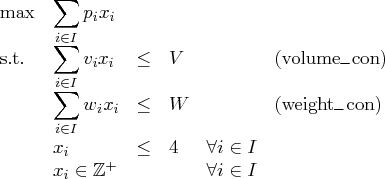| The OPTMILP Procedure |
Example 16.1: Simple Integer Linear Program
This example illustrates a model in an MPS-format SAS data set. This data set is passed to PROC OPTMILP and a solution is found.
Consider a scenario where you have a container with a set of limiting
attributes (volume ![]() and weight
and weight ![]() ) and a set
) and a set ![]() of items that
you want to pack. Each item type
of items that
you want to pack. Each item type ![]() has a certain value
has a certain value ![]() ,
a volume
,
a volume ![]() , and a weight
, and a weight ![]() . You must choose at most four items of
each type so that the total value is maximized and all the chosen
items fit into the container.
Let
. You must choose at most four items of
each type so that the total value is maximized and all the chosen
items fit into the container.
Let ![]() be the number of items of type
be the number of items of type ![]() to be included in the container.
This model can be formulated as the following
integer linear program:
to be included in the container.
This model can be formulated as the following
integer linear program:
Constraint (volume_con) enforces the volume capacity limit, while constraint (weight_con) enforces the weight capacity limit. An instance of this problem can be saved in an MPS-format SAS data set by using the following code:
data ex1data;
input field1 $ field2 $ field3 $ field4 field5 $ field6;
datalines;
NAME ex1data . .
ROWS . .
MAX z . .
L volume_con . .
L weight_con . .
COLUMNS . .
.MRK0 'MARKER' . 'INTORG' .
x[1] z 1 volume_con 10
x[1] weight_con 12 .
x[2] z 2 volume_con 300
x[2] weight_con 15 .
x[3] z 3 volume_con 250
x[3] weight_con 72 .
x[4] z 4 volume_con 610
x[4] weight_con 100 .
x[5] z 5 volume_con 500
x[5] weight_con 223 .
x[6] z 6 volume_con 120
x[6] weight_con 16 .
x[7] z 7 volume_con 45
x[7] weight_con 73 .
x[8] z 8 volume_con 100
x[8] weight_con 12 .
x[9] z 9 volume_con 200
x[9] weight_con 200 .
x[10] z 10 volume_con 61
x[10] weight_con 110 .
.MRK1 'MARKER' . 'INTEND' .
RHS . .
.RHS. volume_con 1000 .
.RHS. weight_con 500 .
BOUNDS . .
UP .BOUNDS. x[1] 4 .
UP .BOUNDS. x[2] 4 .
UP .BOUNDS. x[3] 4 .
UP .BOUNDS. x[4] 4 .
UP .BOUNDS. x[5] 4 .
UP .BOUNDS. x[6] 4 .
UP .BOUNDS. x[7] 4 .
UP .BOUNDS. x[8] 4 .
UP .BOUNDS. x[9] 4 .
UP .BOUNDS. x[10] 4 .
ENDATA . .
;
In the COLUMNS section of this data set, the name of the objective is z, and the objective coefficients ![]() appear in field4. The coefficients
appear in field4. The coefficients ![]() of (volume_con) appear in field6. The coefficients
of (volume_con) appear in field6. The coefficients ![]() of (weight_con) appear in field4. In the RHS section, the bounds
of (weight_con) appear in field4. In the RHS section, the bounds ![]() and
and ![]() appear in field4.
appear in field4.
This problem can be solved by using the following statement to call the OPTMILP procedure:
proc optmilp data=ex1data primalout=ex1soln;
run;
The progress of the solver is shown in Output 16.1.1.
Output 16.1.1: Simple Integer Linear Program PROC OPTMILP LogThe data set ex1soln is shown in Output 16.1.2.
Output 16.1.2: Simple Integer Linear Program Solution
|
The optimal solution is ![]() , and
, and ![]() , with
a total value of 87. From this solution, you can compute the total volume used,
which is 988 (
, with
a total value of 87. From this solution, you can compute the total volume used,
which is 988 (![]() ); the total weight used is 499 (
); the total weight used is 499 (![]() ).
The problem summary and solution summary are shown in Output 16.1.3.
).
The problem summary and solution summary are shown in Output 16.1.3.
| ||||||||||||||||||||||||||||||||||||||||||||||||||||||||||||||||||||||||||||
Copyright © 2008 by SAS Institute Inc., Cary, NC, USA. All rights reserved.
